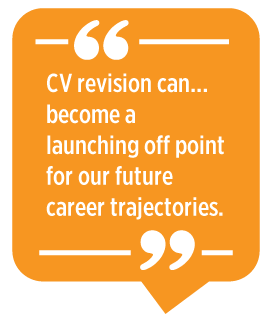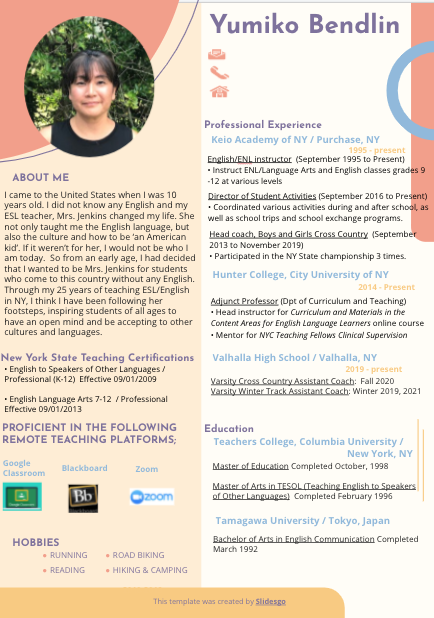Designing an Interactive CV as Professional Reflection
by Laura Baecher

When was the last time you took a really careful look at
your résumé or CV? Why bother with this writing or editing exercise if you’re
not actively job-hunting? There are actually a lot of great reasons to use the
process of examining, reexamining, and reconceptualizing your résumé/CV even if
you are not currently looking for a new position.
In this
article, I use the term CV throughout, although CV usually
refers to a lengthier document that details most or all of one’s professional
accomplishments, while a résumé is usually only one to two pages in length and
has the main highlights (see more on those differences here).
As will be discussed, however, since these documents are becoming increasingly
interactive, even a one-page résumé could really be considered a CV because it
hyperlinks out to multiple other artifacts.
 The Latin
term curriculum vita (CV) literally means the “course of
one’s life”; indeed, our CVs do not just have to be viewed as a formulaic,
required document, but as a window into the roadmap of our careers. Though we
might take a moment sporadically to update our CVs, it is valuable—even
essential—at certain points to stop and review it in its entirety as a form of
reflection on who we are in our work, what we have achieved, and where we want
to go next. By framing the CV revision process as professional development, it
can serve more than just an editing and revising function and become a
launching off point for our future career trajectories.
The Latin
term curriculum vita (CV) literally means the “course of
one’s life”; indeed, our CVs do not just have to be viewed as a formulaic,
required document, but as a window into the roadmap of our careers. Though we
might take a moment sporadically to update our CVs, it is valuable—even
essential—at certain points to stop and review it in its entirety as a form of
reflection on who we are in our work, what we have achieved, and where we want
to go next. By framing the CV revision process as professional development, it
can serve more than just an editing and revising function and become a
launching off point for our future career trajectories.
Five Reasons to Regularly
Update Your CV
-
Adding items to your CV as they occur ensures you don’t forget all
about them.
-
Reviewing what you’ve done helps you feel a sense
of accomplishment as you recall activities you had forgotten about.
-
Considering sections that are a bit thin gives you
an idea of new activities to amplify your profile.
-
Reformatting gives you the opportunity to visually
display that you are staying current in the field.
-
When you see an opportunity arise, you are always
ready to apply!
With all the changes we have experienced
through the pandemic, and the time we have spent supporting the learning of
others, likely using many new forms of technology, this might be the time to
focus inward and invest time in our growth. Using a “Pre-While-Post” structure
works well because it’s a familiar process from the teaching of writing, and
retooling a CV is fundamentally a writing task. Linking it to connected
artifacts just makes it a multimedia writing task!
Pre-CV Review
Before
jumping into some of the design approaches and strategies that can modernize
our CVs, it’s important to step back and reflect:
Equally
important to the resume-writing process is an in-depth reflection on the
characteristics and skills that are most relevant to the job you are hoping to
land. It is this intersection between your experience and skills repertoire and
what is demanded in your targeted role that should be heavily featured in your
career portfolio. Identifying this overlap requires calm, thoughtful, and
careful reflection.(Hardy, n.d.)
Writing a
teaching vision or a professional vision statement can be a way to begin
thinking about and prioritizing your goals (Drew, 2020). Reflective questions
like the ones in Table 1 can be explored as a personal diary response and can
also be fruitful to discuss with a trusted colleague, with a mentor, or in a
supportive community of practice.
Table 1.
Eight Questions to Prompt Career Reflection
|
Remembering Where You Have
Been |
1. What did you
want to be as a child? What parts of those dreams are still part of your life
now?
2. Where
have you worked in the past that really gave you joy? What was it about that
job or workplace that you would love to bring into your life
again? |
|
Taking Stock of Where You Are Now |
3. Name three
aspects of your work life now that you would not want to give up.
4. Name
three aspects of your work life now that you really want to give up!
5. What
kinds of tasks do you engage in currently that you would like to take a step
further?
6. Which
parts of your work now really fill you with a sense of joy, pride, fulfillment,
and accomplishment? |
|
Imagining Where You Want to
Be |
7. What
activities, jobs, or experiences would you like to have in the next 5 years?
8. No matter
what your other responsibilities are right now, what could you do that will
advance you professionally to take you in the direction you want to
go? |
While-CV Review
When you
have a mindset and vision of where you want to steer your career, set aside
several hours for a deep-dive into the substance of your CV. You might want to
create some time in your calendar to return to this task regularly over a
series of weeks because it is very intense and detailed work.
There are
many helpful resources online to guide you in looking at your CV, but it can be
hard to find ones specific to the field of TESOL. Valentina Gonzalez lists a
number of ESL-specific
interview questions, and these can also be used as jumping off points
when auditing your CV. Following are a few TESOL-specific questions to consider
for your CV:
-
What type of English
language teaching curricula are you experienced with? Did you create your own
syllabus and/or teaching materials?
-
Did you teach a specialized
group of students (engineer majors, students with disabilities, dual language
learners)?
-
How did you support English
learners/their families in accessing any learning management systems used to
build your courses? Were your courses in person, online, or hybrid?
-
Did you take on any
leadership duties within your department? Were you on a committee within your
ESL/EFL department? What did you accomplish?
-
What kinds of TESOL methods
are you particularly skilled at? Do you have student work samples to
show?
-
How have you collaborated
with colleagues to support English learners? Do you have examples of coplanning
or coteaching?
-
In
what ways have you engaged in self-reflection on your TESOL practice? Have you
carried out action research projects, video analysis of teaching, or examined
student outcomes?
The next
activity could be carried out as relevant to your professional profile—not all
of the categories are needed! Using the rating tool shown in Table 2 (and
ignoring any of the items that don’t pertain to your position), your CV can be
subjected to a sort of methodical review, and the process of considering these
categories can be helpful in identifying your strengths and recognizing your
achievements, as well as pointing to possible gaps or future directions.
Table 2. CV
Survey Items to Review
|
Rate the following categories
on your CV, as relevant to your line of
work! |
|
1-No or very little evidence
2-Some evidence
3-Very strong evidence |
| |
1 |
2 |
3 |
|
Books (edited,
authored) |
|
|
|
|
Peer-reviewed
publications (book chapters, peer-reviewed journal articles, articles presented
at conferences, forthcoming publications, reports) |
|
|
|
|
Presentations
(local, national, international) |
|
|
|
|
Invited
talks |
|
|
|
|
Keynote/plenary
addresses |
|
|
|
|
Workshops |
|
|
|
|
Honors or
awards |
|
|
|
|
Grants or
fellowships |
|
|
|
|
Magazine or
newsletter publications |
|
|
|
|
Leadership or
administration |
|
|
|
|
Professional
associations |
|
|
|
|
Teaching |
|
|
|
|
Curriculum
development |
|
|
|
|
Engagement in the
public domain (Podcasts, Twitter chats, interviews, blogs) |
|
|
|
|
Certifications
and licensure |
|
|
|
|
Mentoring/advising |
|
|
|
|
Consulting |
|
|
|
|
Volunteer/community activism |
|
|
|
|
Creative
work |
|
|
|
|
Other skills
(languages spoken, technology) |
|
|
|
After this
exhaustive review, what strengths do you see? Where do you see gaps? What steps
can you take to move yourself forward (courses, credentials, volunteering,
leadership roles, publishing)? Consider your career goals to determine which
aspects of your professional profile need to be further developed.
We can’t
excel in every area! It’s really a matter of selectively prioritizing. Are
there certain roles you aspire to move into that require skills you don’t yet
have? Imagine the interview you would like to have for your next job and
“organize your CV to make that outcome more, not less, likely” (Cassuto, 2019).
Post-CV Review
After adding
in the content language you want to include, take a comprehensive look at your
CV and evaluate your organization, formatting, and word choice. Give it to a
friend for 60 seconds, one who is not that familiar with your job history, and
ask them what jumped out for them. What did they pick up on in that time? What
didn’t stand out? Did they identify the achievements you most want the
selection committee to notice? Consider:
|
Organization |
- Is it well-organized and easy to find sections?
- Is it consistent in terms of parallel language and in fonts?
- Is it
understandable by anyone—no local terminologies or
acronyms?
|
|
Formatting |
- Does the appearance seem modern?
- Are the
sections easy to skim through?
|
|
Word Choice |
- Do you focus on duties fulfilled or on accomplishments?
- Do you
hedge or diminish your impact?
|
This is
where many of us will stop—and this is already plenty of self-directed and
valuable professional development! If you are inclined to take things a step
further, consider linking multimedia artifacts to a number of items on your CV
to make it interactive for the viewer.
Interactive CVs
Postpandemic, the expectation that
TESOL educators will have high technological literacy is much greater than
previously. Although paper printouts will continue to be needed and utilized,
CVs today are almost always going to be sent, shared, and reviewed on a
computer screen connected to the internet. Therefore, to indirectly display
your tech-savvy, you can harness the power of digital media to stay relevant in
the job market now and in the immediate future. As you complete your CV survey,
this might be a formatting adventure you decide to embark on—creating an
interactive CV.
Essentially,
making your interactive CV is like crafting a very personal and ambitious
multimedia presentation and “visualizing” your skillsets, according to L.
Michelle Salvant, ThingLink educator and learning and media consultant, in an interview
with Koivula (2020). Savant says:
A
traditional CV is typically text based, and designed for print only. An
interactive résumé on the other hand is a digital based presentation of skills
that allows employers to go beyond traditional print to experience a deeper
more immersive level of exposure to a person’s skills/qualifications. These
types of résumés allow…people to express their qualifications in a more
demonstrative way, through videos, audio, dynamic graphics, etc.
Many tools,
like Thinglink, can be used
to create an interactive CV, but everyday tools like Microsoft Word or Google
Docs and slide presentation tools like PowerPoint or Google Slides can work
just as well. Often, the facade of the interactive CV, if visually appealing, can
stand in front of a very simple hyperlinked document. Piktochart and Canva are free and offer
lots of attractive templates. To get inspiration, simply view ones that are
available online by searching under “interactive CV/résumé”, as highlighted in this
overview (Brown, 2018).
I recently
had a chance to view a friend and colleague Yumiko
Bendlin’s updated interactive CV, created in Google Slides. She has
very generously agreed to share it with us. In it, you can see how the
traditional CV format has been retained, while also bursting through the
boundaries of a word-document only presentation.

“Sample
Interactive CV” by Yumiko Bendlin
is licensed under CC by
4.0.
The best
part? She used this new, interactive CV on a recent job search and landed her
dream job! Time invested in your CV is time invested in your professional
success. Good luck with the process!
References
Brown, Z.
(2018, September 20). Stand out from the crowd with an interactive CV. The UK Domain. https://www.theukdomain.uk/stand-out-from-the-crowd-with-an-interactive-cv/
Cassuto, L.
(2019, July 21). 8 tips to improve your CV. The
Chronicle of Higher Education. https://jobs.chronicle.com/article/8-tips-to-improve-your-cv/
Drew, C.
(2020, February 1). 47 best teacher vision statement examples.https://helpfulprofessor.com/teacher-vision-statements/
Hardy, T.
(n.d.). Executive resume writing: A journey to
self-awareness. https://www.bluesteps.com/blog/executive-resume-writing-journey-self-awareness
LMichelle
Media. (2020, June 22). Media Mondays: Louise Jones journey to
immersive education [Video]. YouTube. https://youtu.be/5lLzKbbs1cU
Dr. Laura
Baecher is professor of TESOL at Hunter
College, City University of New York. Her research interests and publications
relate to teacher education, including educational technology in teacher
learning, observation and coaching for English language teaching, and
professional development in TESOL. Her recent books are Reflecting
on Problems of Practice in TESOL and Video in Teacher
Learning: Through their Own Eyes.